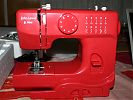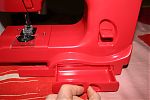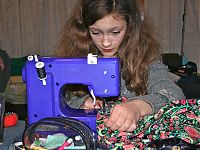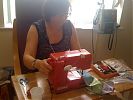I’ve noticed that there’s a lot of talk online about sewing machines for beginners (especially with Christmas coming up!), and I’ve been asked several times online and in person about my opinion on the John Lewis JL Mini sewing machine and I realised I’ve never done a proper review of it.
I’ve had my JL Mini machine (in red – they change the colours a few times a year, but right now it’s offered in white, red, yellow, pink, blue, and purple) for nearly three years now and I’ve recommended it a lot for beginning sewers. On our moorings so far we’ve got my red one, a purple one, and a mint green one! I use mine as my travel machine (I originally got it when I was going into hospital so I could sew through my transplant!), but it’s a good, sturdy machine made by a good brand (Janome), and it has enough features that you should know in a year or two whether you’re into sewing or not and you can upgrade to a machine with more features. Or if you decide sewing’s not for you, you’re not out much money.
So that’s the upsides, but it does have some limitations:
- There’s no light (so you need a well-lit room)
- The foot pedal is on/off rather than any speed control, but I’ve taught absolute beginners on this machine and they’ve been fine with the set speed
- You cannot make buttonholes on it (it has zigzag stitches, but not tight enough or wide enough for buttonholes)
Common misconceptions about this machine:
- You can’t sew thick fabrics. Not true – I’ve sewn everything from denim to stretch jerseys and silks on it. You just need to change your needle accordingly.
- You can’t change the feet. Not true – There’s a screw on the left of the foot, allowing you to use standard low-shank feet (in fact, I highly recommend buying this Hemline “Adjustable zipper foot” for £3 to go with your new machine!) UPDATE: See photos of how to change the presser foot here!
- It’s a crappy toy. Not true – It’s light enough to pick up with one hand and the machine noise certainly isn’t beautiful, but the stitch quality is very good, as you’d expect from a Janome.
My overall feeling is that it’s a great beginner machine because it’s lightweight (you’ll likely be carting it to and from the kitchen table!), cute, and fun, it’ll actually encourage you to sew. There are so many frustrations that beginning sewers face anyway, why make your machine one of them?
(And even if you ignore the above, take one piece of advice from me – NEVER EVER EVER BUY A MODERN SINGER MACHINE. Vintage Singers are great, but modern ones are a total POS trading on the famous name. Awful.)
If you’re after a first sewing activity, you could do worse than making a handy carrying bag for your new machine, like the one I made for my machine! When I taught my beginning sewing friends, I made up a sewing machine driver’s test for them to practice on before threading the machines, and they really appreciated that. So I put it up as a pdf if you want to have a go on your new machine.
Or another option for a beginner might be to buy a vintage machine, as the pre-1980s models were all metal body construction and were built like tanks for everyday sewing. They’re heavy beasts, by and large, but will do all the things you want for a lot less than £100. Even repairs on vintage models are usually under £20 if you know anyone in the family with one they’re not using, or start trawling eBay, Gumtree, or Craigslist for vintage machines (just make sure you can get a manual for it!).
Happy shopping!
Full disclosure – I’m testing out a new affiliate programme, so if you buy through my links, I’ll get a few pence. But I had this post saved as a “draft” for months – well before I joined the programme, so I was planning on posting about this anyway…




